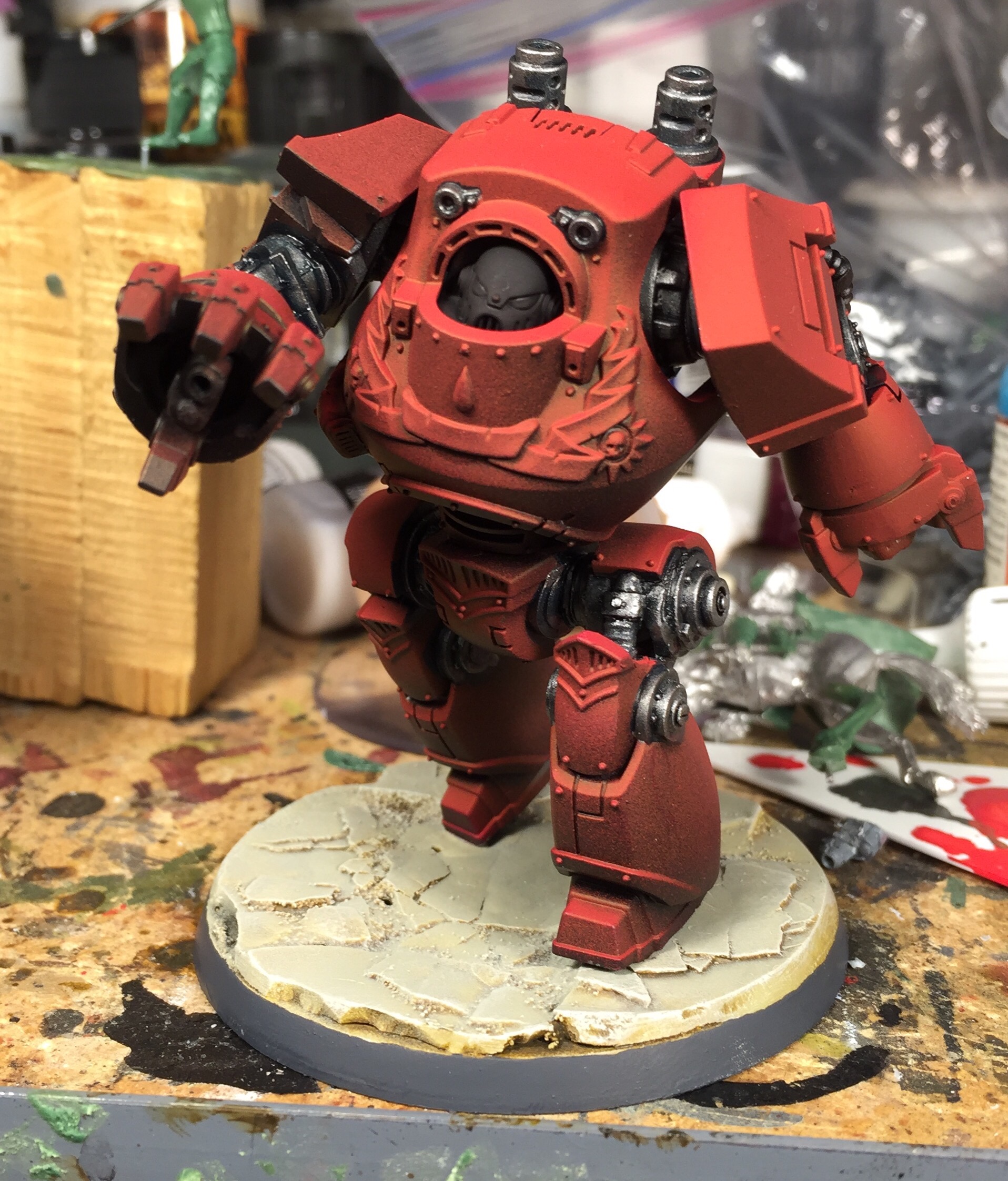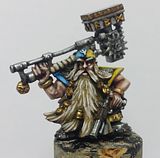These past six months, I've been using white or light colours more and more on my miniatures, and it is generally very well recieved - which I think very much comes from it being a colour which holds very much beauty in it, and responds very well to its surroundings if painted well. It serves as an eyecatcher, yet seldom "drown" the model - on the contrary, it tends to enhance whatever other details you've painted, giving them the focus.
White is however, quite challenging to paint, which probably is the reason behind it being so popular but still so seldom used. It doesn't cover very well, it seldom flows the way we want, and if you're not careful, you'll use too much and your model's details will be washed out or disturbed, as mounds of dried white paint or tracks from brushstrokes all of a sudden covers the surface you so gently had removed mold lines from, or even taken so long time sculpting yourself.
In this tutorial, I'll try to share a few thoughts, tips and tricks I've learnt through trial and error, and also after my best abilities describe the different techniques I've used to achieve the results on some of my own favourite miniatures.
As I undercoat my miniatures with black spray, it wouldn't surprise me if some of the problems (and solutions to them) that I describe, will be different if not nonexistent for those undercoating white or grey. Also, I exclusively use paint from Games Workshop, so my observations are based upon my experiences with those paints. Likewise, any reference to names will use GW-names, but if you prefer other brands and/or don't have any experience with the GW paints, then
this site should help you find the right colour from your preferred paint brand.
One of the first problems that many experience, is that Skull White is a rather thick paint, and easily clogs - or it turns that way rather quickly. So to make it flow better, dilute with water, but then it turns out to be very translucent, and this presents a problem when used over dark surfaces (Chaos Black for example), as you end up with grey spotted with white grains, instead of white. Problem leads to a new problem.
There are several ways to cope with this, and in my early painting days, I recall I simply used very much paint on my very wet brush, and just gave the surface a generous layer. This was before I started using a palette, dry as well as wet, so wet brush into the can of paint was the way to go. And after a fashion, it worked quite well - that was as long as the surface was flat and without details sculpted into it; bolts, small cracks etc, would easily drown under this layer of wet paint, so that was sort of a minus. Also, using so much paint took a long time to dry, and what's worse is that gravity's pull on the paint would easily make it run slooowly as it dried, thus create uneven parts if you didn't manage to leave the miniature to dry in a fashion, that held the painted surface horizontal. And finally this technique is not a viable option if the surface you intend to paint white holds nicely sculpted details you wish to keep visible, if the surface is curved in any way or if you want the white to be shaded.
So, I have found two other main techniques for making the white look white:
First option is to place layer upon layer of diluted paint upon the surface, which will make for a white finish in the end, and if you give certain areas fewer layers than others, you'll be able to create areas of shade and light. It is a lengthy process, though, but worth it if you stick through to it in the end.
The second option is to mix your Skull White with another colour, and work your way into brighter and brighter colours by adding more and more white to the mix for each layer you paint. Like the first option it is important to dilute your paint, or else the sheer number of layers will remove all the details.
It is of course possible to combine those two, as you'll see in one of the examples I've described below, and for both options - but especially the second - using a
wet palette really helps!
The second option presents lots of possibilities which I thought I'd adress now, namely which colours to blend the white with. It has to be a colour with enough pigment to cover the black easily, but it shouldn't be too dark neither, 'cos then you'll need a lot of "unneeded" layers, compared to using an already light colour. For this purpose, I find the relatively new Foundation paints from GW to work perfectly. My two favourites are Astronomican Grey and Dheneb Stone, which respectively yields a cold and a warm tone of white. One can also make more complicated mixes, for instance by using Bestial Brown with more and more Bleached Bone added to the mix, and when it gets light enough you start adding Skull White, one can create a sort of creamy colour. I am also positive that one can use several of the other Foundations with good effect: Tallarn Flesh, Iyanden Darksun and Gretchin Green springs to mind as colours I'd like to experiment with in the future.
Now, what's the deal with all these different mixing colours? Why not just stick to Astronomican Grey, as it lies closest to Skull White, and thus should yield the "best" white? Well, that's mostly true, Astronomican Grey and Skull White makes a great white, but in some cases, pure white is not what you want. See, the mixing colour (eventually brightened up a bit with Skull White) not only serves as the "darkest shade" of the white, but it's also a major factor when it comes to how the white harmonizes with the other colours of the model. I'm thinking especially on the balance between warm and cold colours and what you want your white colour to do. So before you decide on how to paint your white, ask yourself the following question:
What do I want my white to do? Do you want your white to be in contrast with the rest of the model? An eye-catcher or point of focus? Is white the main colour of the model? Or do you want the white to compliment the other colours, be more anonymous and in the background.
Let my try to illustrate what I mean with a couple of examples taken from my own models:
The white on my Marauder Horsemen is concentrated mainly on the horses, creating a cold sphere with a warm core in the form of the rider. The viewer's focus will then be on the rider, which after all is the "main character" of the model, while the horse serves more as an enhancing factor.

For that reason, I choose my Astronomican Grey as mixing colour, as it gives the white an extra icy edge. I started by covering the flesh of the undercoated horse with two thin layers of watered down Astronomican Grey, the last one with some Skull White taken into the mix for a slightly lighter colour. Then I actually continued to add thin layers of only diluted Skull White on top of every raised area. I repeated this step until I got a pure white as a highlight - the number of layers depend on how much white you mix in with your Astronomican Grey in the second stage.
Now for the hardest bit. At this point, the darkest areas of shade, will be too dark compared to the whitest of the white. If not, you're simply better at mixing colours than I am, heh. See, it's very easy to make a too light shade at the beginning, which makes your model look flat and without shadows in the end - after all, white only goes to a certain point in lightness, you can't highlight it further. So I usually make my Astronomican Grey+Skull White mix "too dark" on purpose, and then light it up.
I make a very thin glaze of Skull White and plenty of water, and then like a wash or ink, brushes it onto the model. Make the layers thin - you can always repeat them, but never redo them, so be careful in the beginning - and with a spare and dry brush, I gently remove the paint that gathers in any recess (the areas we want to look like shade).
While reading, it might seem a bit pointless - why paint something just to remove it again? Well, when you try it, you'll see that you won't be able to remove it all without adding aditional water, and a thin layer will stick, and like glazes should, just slightly affect the underlying colour.
It sure is a lengthy process, and you might have noticed that I combined the two main techniques for painting white I described earlier that I'm using, plus the extra bit with the white glaze on top. It wouldn't surprise me if there are other methods which yields as good results as this one, if not better, but this is one of my methods of painting white - and with a good record on, time flies!
Now, that was an example using cold white to create contrast, yet give focus to another part of the model. Let's see how a warm white can be used:
At the time of writing, I'm working on a unit of Bretonnian Pegasus Knights, and the first Pegasus I made was painted white. I didn't want it to be completely white - they're not meant to be peace doves! - so I found some images of birds of prey, specifically hawks, which are mostly white but with dark browns mixed in between. Brown being a rather warm colour, combined with a warm purple caparison, would create some conflict if I made my white colour cold. Especially the blending from white to dark brown and black at the tips of the primary feathers (biggest at the tip of the wings), would be difficult, if there was a temperature difference. Now this is a quite different scenario than the Marauder and his horse; here I want the white to blend in with the rest, and I try to keep a warm feel to the whole miniature.

So, for this minature, I used Dheneb Stone as my mixing colour - I actually mixed a tiny incy bit of Scorched Brown into it, to get a very soft hint of pink in it. Then I covered all fleshy areas with a watered down layer, then made a new mix with Skull White added, and kept on making new layers with more and more Skull White into the mix. So this time I stuck to the second technique of mine, rather exclusivly, until I gave a final highlight of pure white. I did use my white glazing technique in the end, as I once again had made a too dark shade. Also note that I've added some texture to the neck of the Pegasus, by leaving a shaded area running down the neck. On most horse models, it is sculpted into it (actually on the other set of heads for the Pegasus, there is..), but I mention it mostly to demonstrate how one can try to create the illusion of different muscles underneath the skin.
I did the wings in very much the same manner, barring the blending from whitest to Scorched Brown to Chaos Black at the very tips. Here I tried to use the white to draw focus towards the centre of the model, by painting the proximal part of the feathers lightest white, while the fading towards black was distal. Another difference I did was mix some Bleached Bone into the Skull White and Dheneb Stone mix, and use it a bit at random - I'm not sure why I did it, but it felt right to do - I don't know if it makes it look like more natural wings or what. But that's basically my method for painting a warmer white. But do yourself a favour, and use a wet palette, it'll enable you to going back and forth between different colour values almost effortlessly, and also keep your mixed tones of white wet and ready for use for a long time at a time, so you can keep the same colour all through the model.
Lastly in this tutorial, I thought I'd adress the issue of painting freehands using white, upon dark surfaces. There's an example of that on my Marauder Horseman's shoulderpad, where I've painted the Mark of Slaanesh, and at the local GW that in particullar has recieved some praise. It is however, not as hard as one might think, to achieve that. If you recall, I initially described how white usually turns grainy grey if watered down and painted upon a dark surface, and personally I prefer to use quite diluted paints when working on freehand designs; which presents a problem. Or it should have, if not for this simple solution:
simply mix your white with a high pigment colour like Astronomican Grey - you won't get a 100 % white, true, but you can add water to the mix without problems, and get a very light grey as a result. And a very light grey painted on top of black, says "white" in most people's brains, so it's quite hard to spot that you've been "cheating".
With that I'll end this tutorial, and I hope this collection of thoughts, tips and tricks can be of help!










































































































